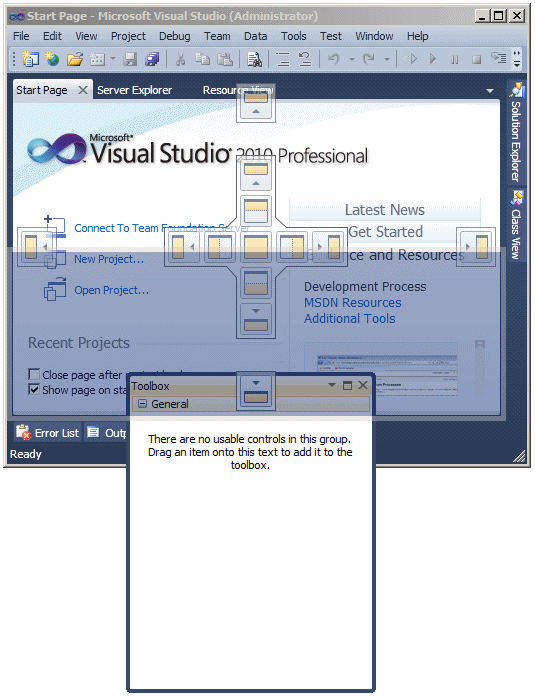|
The Microsoft Visual C++ Environment
|
|
|
|
Microsoft Visual C++ is a programming environment used
to create applications for the Microsoft Windows family of operating
systems. To use these lessons, you must have installed either Microsoft
Visual Studio 2010. Although Microsoft Visual Studio 2010 Professional
provides many programming environments for the price of one, in our lessons,
we will use it but we will cover only the Microsoft Foundation Class (MFC)
library side.
|
After installing it, to use the programming
environment, you must first open it. To do that, you would click Start ->
(All) Programs -> Microsoft Visual Studio 2010 -> Microsoft Visual Studio
2010.
In our lessons, unless used in code, the -> arrow
means an action that should follow another. Based on this:
- Edit -> Copy means click Edit, then click Copy
- View -> Toolbars -> Custom means click View position the mouse on
Toolbars, and then click Custom
|
 Practical
Learning: Launching Microsoft Visual C++ Practical
Learning: Launching Microsoft Visual C++
|
|
- To start Microsoft Visual C++ or Visual Studio, on the Taskbar,
click Start (All) Programs -> Microsoft Visual Studio 2010 ->
Microsoft Visual Studio 2010
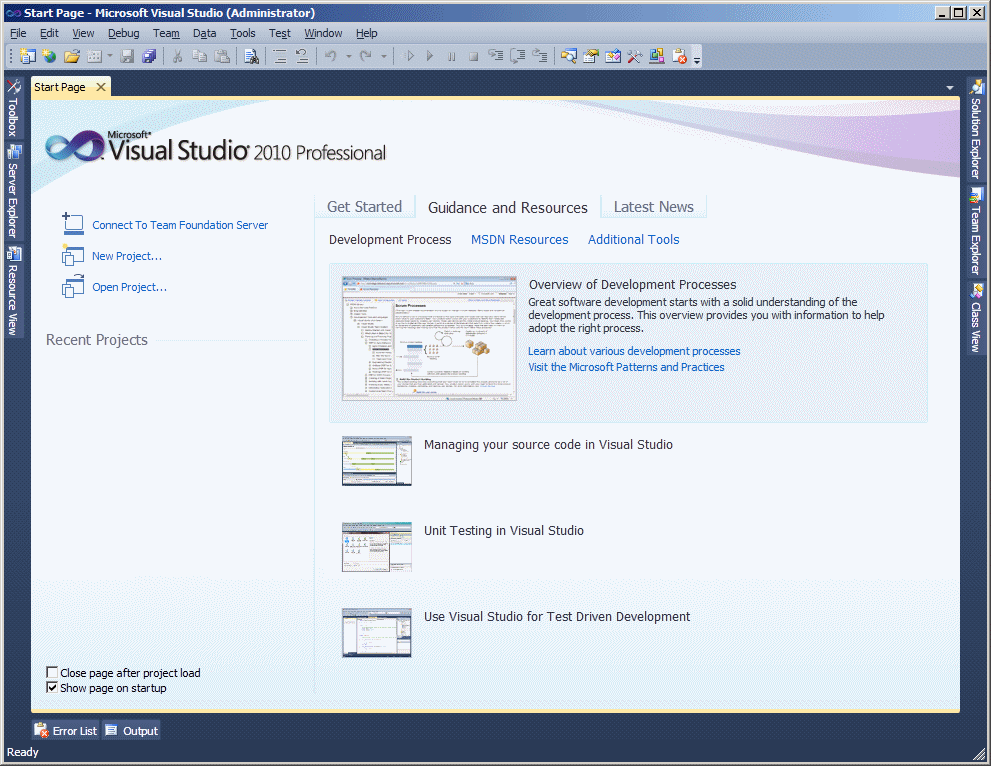
|
The Integrated Development Environment
|
|
After Microsoft Visual Studio has been opened, the
screen you get is called an Integrated Development Environment or IDE. The
IDE is the set of tools you use to create a program.
The title bar is made of three section. The left
section shows the system icon. The system icon is used to identify the
application that you are using. Almost every application has its own
system icon. The system icon holds its own list of actions; for example,
it can be used to move, minimize, maximize or close (when double-clicked)
a window.
The middle section of the title bar displays Microsoft
Visual Studio. This starting title displays in the beginning until you
decide to create a particular type of application, then the title changes.
You will experience it once we start some programming assignments. The
middle section of the title bar can be also used to move, minimize,
maximize the top section of the IDE, or to close Visual Studio. You can
perform these actions by right-clicking the title bar and selecting from
the menu.
The right section of the title bar shows three system
buttons:
| Button |
Role |
 |
 |
 |
Minimizes the window |
 |
 |
 |
Maximizes the window |
 |
 |
 |
Restores the window |
 |
 |
 |
Closes the window |
The main menu under the title bar is used to perform
all types of actions on the IDE. In our lessons:
- The expression "main menu" refers to the menu in the top section
of the IDE
- MSVC means Microsoft Visual C++.
A toolbar is an object made of buttons. These buttons
provide the same features you would get from the main menu. Under the main
menu, the IDE is equipped with a Standard toolbar used to create a new
project, open a file, save a project, etc.
Besides designing applications, one of your most
regular jobs will consist of writing code that directs the computer as to
what to do, when, and how to do it. This is done in an appropriate window
called the Code Editor.
The Code Editor is a feature-rich text editor
programmed to recognize the parts of a program that belong to C++ or not.
The Code Editor manages your jobs by organizing its files into labels or
tabs. If your project contains more than one file, you can click the
desired tab to access one of the files.
The basic building block of a program is called a C++
file. Whenever you create a new project, the Microsoft Visual Studio
programming environment creates various files, such as header files and
source files. To display a header file, you can double-click its name in
the Class View. Since the source and the header file go in pair (when
using classes), they hold the same name but have different extensions.
A toolbar is an object made of buttons. These buttons
provide the same features you would get from the (main) menu, only faster.
Under the main menu, the Integrated Development Environment (IDE) is
equipped with the Standard toolbar.
By default, when you start Microsoft Visual Studio, it
is equipped with one toolbar: Standard. To get more toolbars, on the main
menu, you can click View -> Toolbars and click the toolbar of your choice.
You can also right-click any available toolbar or the main menu. This
displays a list of all the available toolbars. Those that are currently
opened have a check mark next to them.
A toolbar is equipped with buttons. To know what a
button is used for, you can position the mouse on top of it. A tool tip
will come up and display for a few seconds. In our lessons, each button on
any toolbar will be named after its tool tip. This means that, if a tool
tip displays "New", its button will be called the New button.
Microsoft Visual Studio's menus and toolbars can be
customized. You can customize a menu category on the main menu by adding a
menu item to it. You can customize a toolbar by adding a button to it. To
start, right-click anything on the main menu or on any toolbar and click
Customize... For example, imagine you want to add an item named Start
Without Debugging so that it would let you easily execute your projects
and you want to add its button to the Standard toolbar, and imagine you
want to position it on the left side of the Start button:

To proceed:
- You can right-click any button on any toolbar or right-click the
main menu and click Customize
- On the Customize dialog box, click the Commands tab
- Click the Toolbars radio button
- In the right combo box, select the toolbar to which you want to
add a button. In this case, that would be Standard
- In the Controls list, click the button that will succeed the one
you want to add. In this case, this would be Start / Continue:
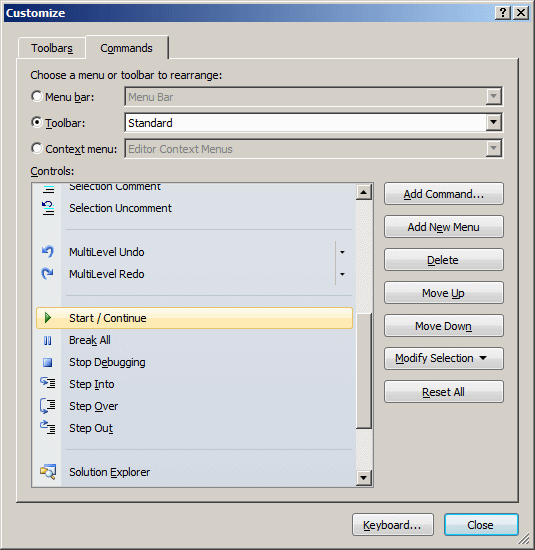
- In the right list, click Add Command
- In the Add Command dialog box, in the Categories list, select the
category that has the button you want
- In the Commands list, click the button or menu item you want. For
our example, that would be Start Without Debugging

- After makiing the selection, click OK
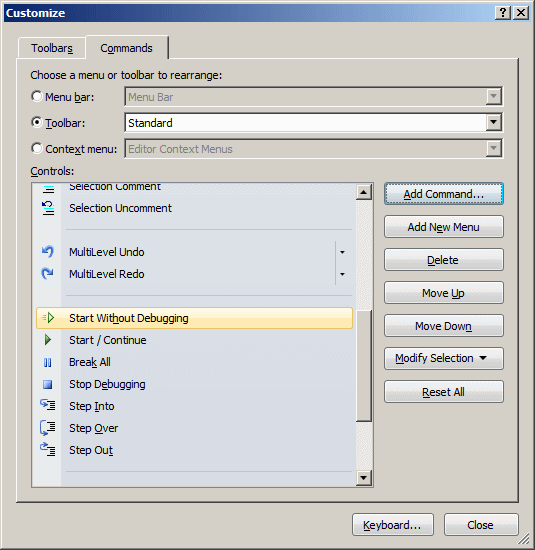
- On the Customize dialog box, click Close:

In the same way, you can customize any toolbar and any
menu category.
The Start Page is the first wide area that appears
when Microsoft Visual Studio comes up. The left section displays a list of
recently used projects under Recent Projects. At any time, to display the
Start Page:
- You can click the Start Page label in the top section of the Code
Editor
- On the main menu, you can click View -> Start Page
If you have just installed Microsoft Visual Studio or
have not previously opened a project, the Recent Projects section would be
empty. Once you start creating and using projects, they display in the
Recent Projects section by their names.
|
Showing and Closing a
Window
|
|
When you start or open a project, Microsoft Visual
Studio makes some windows available. These are the most regularly used
windows. If you think that one of them is not regularly used in your types
of assignments, you can remove it from the screen. To hide a window, you
can click its Close button
 .
.
All of the windows you can use are listed in the View
menu. Therefore, if a window is not displaying, you can click View on the
main menu and click a window of your choice.
|
 Practical
Learning: Showing the Windows Practical
Learning: Showing the Windows
|
|
- On the main menu, click View -> Solution Explorer
- Again, on the main menu, click View -> Toolbox
When working on a project, you will use a set of
windows that each accomplishes a specific purpose. Some windows are
represented with an icon but hide the rest of the body. To display such a
window, you can position the mouse on it. This would expand the window:
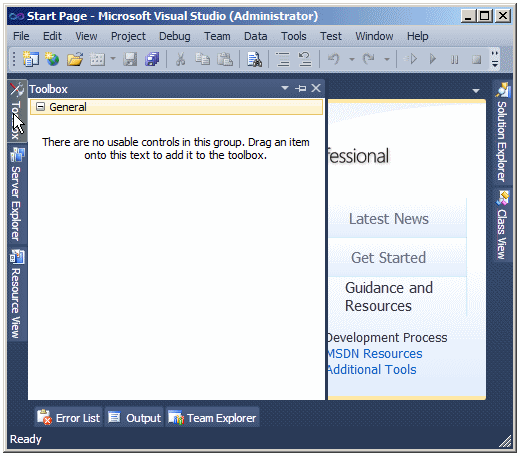
If you expand a window, it would display a title bar
with three buttons. One of the button is called Auto Hide:

If you expand a window but find out you don't need it
any more, you can just move the mouse away. The window would return to its
previous state. Based on this functionality, if you are working with a
window and move the mouse away, it would retract. If you need it again,
you would have to reopen it using the same technique. If you are going to
work with a certain window for a while, you can keep it open even if you
move the mouse away. To do this, you can click the Auto Hide button. If
clicked, the Auto Hide button changes from pointing left to pointing down:
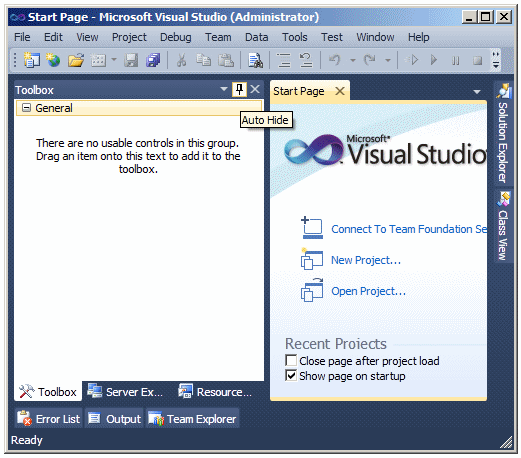
By default, Microsoft Visual Studio installs some
windows to the left and some others to the right of the screen. You can
change this arrangement if you want. To do this, expand a window, then
click its title bar and start dragging. While you are dragging, to assist
you with a new position, the studio displays five boxes:
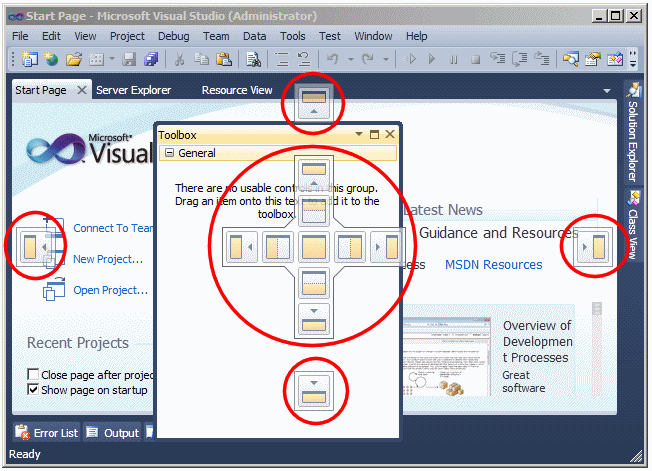
|
Docking a Window to a Side of the Studio
|
|
To position a window on one side of the screen, drag
its title bar to the box that represents that side. When you get to a
side, a transparent blue rectangle would be drawn to indicate the possible
position. Drop the window to either the most right guiding box to position
it to the right of the screen, or to the most left guiding box to position
it to the left of the screen. Here is an example:
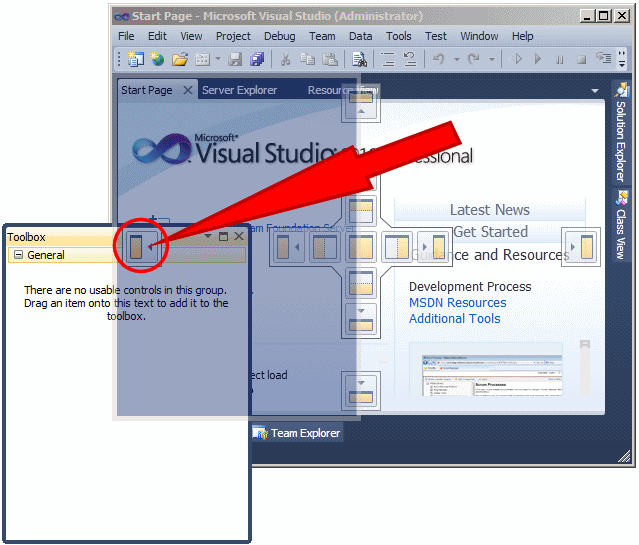
or

To position a window to the top or the bottom side of
the studio, drag its title bar to either the most top guiding box to
position it to the top of the studio or to the most bottom guiding box to
position it to the bottom of the studio. Here is an example:
